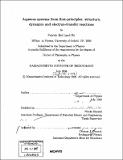Aqueous systems from first-principles : structure, dynamics and electron-transfer reactions
Author(s)
Sit, Patrick Hoi Land
DownloadFull printable version (12.85Mb)
Other Contributors
Massachusetts Institute of Technology. Dept. of Physics.
Advisor
Nicola Marzari.
Terms of use
Metadata
Show full item recordAbstract
In this thesis, we show for the first time how it is possible to calculated fully from first-principles the diabatic free-energy surfaces of electron-transfer reactions. The excitation energy corresponding to the transfer of an electron at any given ionic configuration (the Marcus energy gap) is accurately assessed within ground-state density-functional theory via a novel penalty functional for oxidation-reduction reactions that appropriately acts on the electronic degrees of freedom alone. The self-interaction error intrinsic to common exchange-correlation functionals is also corrected by the same penalty functional. The diabatic free-energy surfaces are then constructed from umbrella sampling on large ensembles of configurations. As a paradigmatic case study, the self-exchange reaction between ferrous and ferric ions in water is studied in detail. Since the solvent plays an central role in mediating the process, studying electron-transfer reactions requires us to first understand the structure and dynamics of the solvent molecules (water molecules in our case). Therefore, we have also studied the static and dynamical properties of (heavy) water at ambient conditions with extensive first-principles molecular-dynamics simulations in the canonical ensemble, with temperatures ranging between 325 K and 400 K. (cont.) Density-functional theory, paired with a modern exchange-correlation functional (PBE), provides an excellent agreement for the structural properties and binding energy of the water monomer and dimer. On the other hand, contrary to a long-standing belief, the structural and dynamical properties of the bulk liquid show a clear enhancement of the local structure compared to experimental results; a distinctive transition to liquid-like diffusion occurs in the simulations only at the elevated temperature of 400 K. The local coordination and structure of water is still a very debated matter and in collaboration with experimentalists at the European Synchrotron Radiation Facility in Grenoble, we have characterized the structure and the local environment in water with a combination of inelastic X-ray scattering and first-principles calculations, under conditions ranging from the normal state to the supercritical regime. The same temperature dependence of the Compton profile is observed in experiment and simulation. A well-defined linear correlation is identified between Compton profile differences and changes in the number of hydrogen bonds per molecule, that is consistent with well-established structural models, and that confirms the prevailing picture of hydrogen bonding under normal conditions. (cont.) While close to the critical point we observe a clear signature of density fluctuations, supercritical water is characterized by a sharp increase in under-coordinated clusters, with a significant number of dimers and trimers. Last, we implemented a Hubbard U correction in our first-principles molecular dynamics to improve the hybridization between a transition metal ion and its surroundings. The implementation has been tested for ferrous and ferric ions solvation in water. The effects of the Hubbard U correction on the electron-transfer reaction is also studied.
Description
Thesis (Ph. D.)--Massachusetts Institute of Technology, Dept. of Physics, 2006. Includes bibliographical references (p. 127-141).
Date issued
2006Department
Massachusetts Institute of Technology. Department of PhysicsPublisher
Massachusetts Institute of Technology
Keywords
Physics.